Retro Corner: Rival Turf
When the arcade smash hit scrolling beat-em-up from Capcom – Final Fight – was ported onto the Super Nintendo in 1991, the game was a huge success. Considering the limitations of the home console, Capcom managed to put together a very faithful adaptation, that was very close to the real arcade experience. Except for one glaring omission – there was no two-player option.
Of course, many fans noticed this and the fact became a real issue. Players who had enjoyed the game greatly in their local arcades wanted to play through at home with a friend, as scrolling beat-em-ups are always more fun when played with a partner. Other game developers obviously noticed this fact too, and Japanese developer Jaleco looked to take advantage of this shortcoming just a year later.
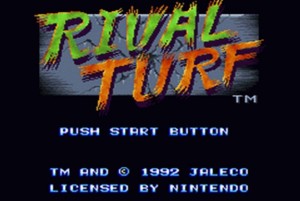 Their answer would be Rival Turf (known as Rushing Beat in Japan), and the game even boasted on its front cover that it featured two player action – a fact that, considering the shortcomings of Final Fight in that particular area, could actually make the game a much more attractive prospect.
Their answer would be Rival Turf (known as Rushing Beat in Japan), and the game even boasted on its front cover that it featured two player action – a fact that, considering the shortcomings of Final Fight in that particular area, could actually make the game a much more attractive prospect.
The setup for the game is very much your run-of-the mill scrolling beat-’em-up storyline. Our main character Jack Flak (how imaginative, a rhyming name – albeit changed from the less ridiculous original Japanese name of Rick Norton) finds out that his girlfriend Heather has been kidnapped by evil gang known as the Street Kings, and their infamous leader Big Al. Jack obviously needs to rescue her, but calls in for help from his police officer friend, Oswald “Oozie” Nelson (known as Douglas Bild in the Japanese version – who also sees his skin darkened to appear of African-American origins for the North American release).
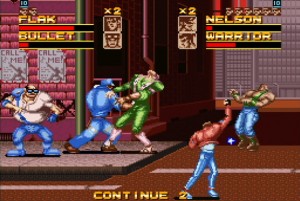 The game from there proceeds to put players through six different stages that will take the player to many of the old cliche locations from side-scrolling games, such as urban streets and warehouses, but also to more unique areas, like the football stadium and into the mountains; all the while working your way through waves of enemies and bosses, in order to reach the leader of the gang.
The game from there proceeds to put players through six different stages that will take the player to many of the old cliche locations from side-scrolling games, such as urban streets and warehouses, but also to more unique areas, like the football stadium and into the mountains; all the while working your way through waves of enemies and bosses, in order to reach the leader of the gang.
The many enemies are very typical generic villains – those that have been seen in almost every fighting game ever made. All the obvious stereotypes make an appearance; tall, skinny characters, short, fat guys, Karate men and of course, many faceless street punks. The names are a bit more unusual, with Ninjas named Dingo, or the slim man known as Skinny, for instance, but I think that perhaps a little has been lost in the translation from Japanese in some of the names. They all have their own attack styles and special moves – but the whole game consists of the same basic enemies, so things get pretty repetitive, pretty quickly.
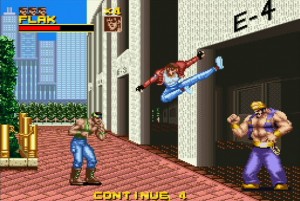 The boss characters all show a little more imagination, but are also a bit confusing. Why is there a huge bad guy dressed up as the Genie of the Lamp, protecting the Football stadium? And did I mention that he wields a sword? Then there is Slasher, who is an obvious Vega rip-off from Streetfighter II, in both looks and moveset. Perhaps strangest of all is Ice Man – a figure-skater wearing a Mexican Wrestling mask, who attacks you during the dockside level (inexplicably). After all of these colourful characters, it is rather a disappointment when we get to the final boss in Big Al, and realise that he is your generic Karate/Kung Fu character – complete with Ryu style attire.
The boss characters all show a little more imagination, but are also a bit confusing. Why is there a huge bad guy dressed up as the Genie of the Lamp, protecting the Football stadium? And did I mention that he wields a sword? Then there is Slasher, who is an obvious Vega rip-off from Streetfighter II, in both looks and moveset. Perhaps strangest of all is Ice Man – a figure-skater wearing a Mexican Wrestling mask, who attacks you during the dockside level (inexplicably). After all of these colourful characters, it is rather a disappointment when we get to the final boss in Big Al, and realise that he is your generic Karate/Kung Fu character – complete with Ryu style attire.
Thankfully the two characters who you can choose from do play somewhat differently, so gamers can choose the style which best suits them. Jack Flak is the faster of the two, and with less power, relies on special attacks such as his flying kick and back drop to take down his opponents. Oozie Nelson, however, is the powerhouse of the duo, with his wrestling-based attacks doing more damage, but his recovery times seriously lacking. The game is most fun when played with a friend, as you would expect, and the two of you take one character each, but the game does default to a mode where you can hurt each other; which will happen almost constantly. Thankfully this can be disabled, because otherwise it is likely that Jack and Oozie will damage each other more than the bad guys.
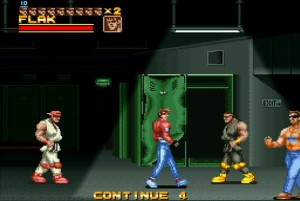 The game also controls quite stiffly, but the characters appear to glide or skate around the levels, with poorly animated walk cycles. Care and attention to detail certainly aren’t the words of the day when describing Rival Turf, and the fact that the repetitive punch, kick and grab controls are a bit sluggish makes things all the more frustrating. On top of your regular moves, there are the usual bricks, bottles and knives scattered throughout levels to help you cause more mayhem, but aiming and connecting properly with these can be very hit and miss – quite literally!
The game also controls quite stiffly, but the characters appear to glide or skate around the levels, with poorly animated walk cycles. Care and attention to detail certainly aren’t the words of the day when describing Rival Turf, and the fact that the repetitive punch, kick and grab controls are a bit sluggish makes things all the more frustrating. On top of your regular moves, there are the usual bricks, bottles and knives scattered throughout levels to help you cause more mayhem, but aiming and connecting properly with these can be very hit and miss – quite literally!
Things are shaken up a little by the ‘Angry Mode’ which becomes available when you have taken a heavy amount of damage already. This will make your character move a lot faster, allowing for quick combos of moves, and increase your power temporarily. This will definitely help you get out of a tight spot and is particularly useful in boss battles.
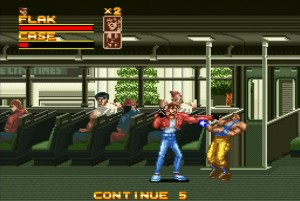 There isn’t much on offer in the game once you have completed the story mode – which in itself isn’t particularly long. The game does also have a two-player versus mode, but this is a very simple one-on-one fighter, on a single screen, where the victor wins a best of three series. This mode certainly won’t keep you occupied for long – or at all – so you’re not missing much if you give it a miss entirely. One amusing feature is that after the player has completed the game once, they are given the option to rename all of the bad guys, one by one, to anything that they like. I certainly had fun beating up bad guys named after all my school friends when I was younger, but unfortunately these names all reset after you turn off the console.
There isn’t much on offer in the game once you have completed the story mode – which in itself isn’t particularly long. The game does also have a two-player versus mode, but this is a very simple one-on-one fighter, on a single screen, where the victor wins a best of three series. This mode certainly won’t keep you occupied for long – or at all – so you’re not missing much if you give it a miss entirely. One amusing feature is that after the player has completed the game once, they are given the option to rename all of the bad guys, one by one, to anything that they like. I certainly had fun beating up bad guys named after all my school friends when I was younger, but unfortunately these names all reset after you turn off the console.
As a Final Fight clone, Rival Turf did a thoroughly average job. There is little to make the game stand out (aside from the two-player mode) and there are really no areas in which it excels. The graphics are average, animation poor, the music is horribly irritating and almost everything else is exactly what you would expect from a bog standard fighting game. If it wasn’t for the appeal of multiplayer, the game would have most likely faded into obscurity but, instead, the game found a place in the market at the time of release. It even spawned two sequels, including the well-received Brawl Brothers, and both of these follow-ups were much more worthy challengers to Capcom’s crown. So perhaps when you look back at Rival Turf as the first entry in a series which improved greatly, you can give it a little more leeway. It can still provide some quick, mindless two-player brawling fun though.
Rival Turf is available for download via the Wii Virtual Console service, as is its sequel Brawl Brothers. The God is a Geek Retro Corner will return on the first Friday of next month. You can see previous entries into the GodisaGeek Retro Corner by clicking here.




